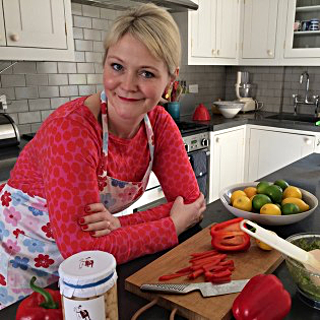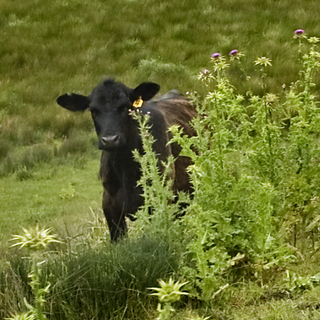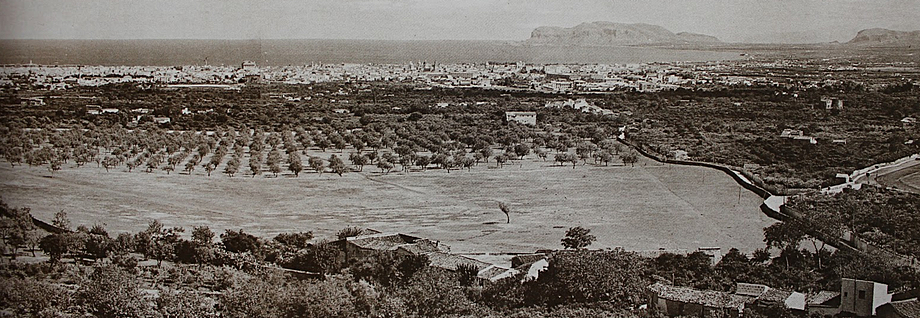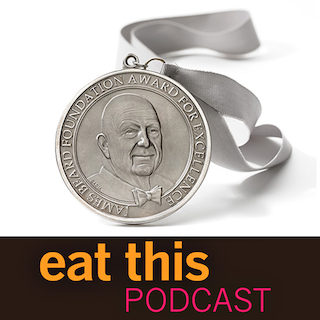A Culinary History of Spam landed in my Other Podcasts feed the other day. Interesting stuff, in the two-geezers-talk-to-one-another-about-stuff-they’ve-learned genre. Of course I wasted no time in pointing the two geezers, who happen to be women, to my own offering on Spam. You might like it too.
Enjoying life on a rather restricted regimen The author of How to eat (when you can't eat anything at all)

Podcast: Play in new window | Download (Duration: 15:32 — 11.3MB)
Subscribe: Google Podcasts | Spotify | Android | RSS | More
 By great good fortune, there is nothing I cannot eat. There are a couple of things I’d prefer not to eat, but nothing, at least as far as I know, that would make me ill. As a result, I am fascinated by people who have to forego certain foods to stay well. I used to follow someone on the web who swore that something called the Specific Carbohydrate Diet™– which, I learn, apparently requires initial caps and a TM symbol — was the only thing that kept her alive. I never really investigated further, because that was before I had a podcast to feed and she more or less stopped writing about it. So when the chance arose to talk to someone who is living with the disease and the diet, I leaped at it.
By great good fortune, there is nothing I cannot eat. There are a couple of things I’d prefer not to eat, but nothing, at least as far as I know, that would make me ill. As a result, I am fascinated by people who have to forego certain foods to stay well. I used to follow someone on the web who swore that something called the Specific Carbohydrate Diet™– which, I learn, apparently requires initial caps and a TM symbol — was the only thing that kept her alive. I never really investigated further, because that was before I had a podcast to feed and she more or less stopped writing about it. So when the chance arose to talk to someone who is living with the disease and the diet, I leaped at it.
Victoria Young is a journalist who has been following the SCD™ for about seven years. She says that it has actually renewed her relationship with food, partly by making her think hard about what she eats. Far from being a dull diet that is all about avoiding things, it forces her to be inventive with the things she can eat. And she says she’s never felt better. The medical establishment may not be too keen on the SCD™ but the proof of the pudding — assuming you can in fact make a pudding that complies — does seem to be in the eating.
Notes
- Victoria Young’s website links to her blog How to eat (when you can’t eat anything at all). She tweets @tory21.
- The mother lode on the SCD™ is Elaine Gottschall’s book Breaking the Vicious Cycle: Intestinal Health Through Diet.
- Once again, I’m plaintively asking you to rate and review the show on iTunes. I know that’s pathetic, but it honestly does help.
- The banner photo of a stained section of inflamed bowel is from Wikimedia, and doesn’t it take me back …
Grass-fed beef A better way of putting meat on the table

Podcast: Play in new window | Download (Duration: 17:38 — 12.7MB)
Subscribe: Google Podcasts | Spotify | Android | RSS | More
 What kind of business wants customers to buy less? The beef business, or at least, one tiny corner of the beef business.
What kind of business wants customers to buy less? The beef business, or at least, one tiny corner of the beef business.
Mark Shelley is an environmental film-maker turned cattleman who raises grass-fed beef near Carmel, California. The methods he and many others have adopted make beef far less environmentally damaging than industrial methods. Quite apart from anything else beef is, as Mark puts it, “the big elephant in the room” when it comes to climate change. Anything to address that ought to be welcomed, and grass-fed beef is far less damaging. It does, however, cost more, not least because we’re all paying the external costs of industrial meat. That’s fine, Mark says. We should all be eating better beef, just doing so less often. How to make that happen? Mark has no idea, he’s just doing his bit, one piece of meat at a time.
Mark’s recent visit to Italy offered the chance to find out more. I completely forgot to ask him about the drought.
Notes
- Tassajara Natural Meats has a website. I reckon they’re too busy taking care of the cattle to take much care of the website.
- Photo by Carrie Cizauskas, used with permission.
- You may remember that ages ago Eat This Podcast talked about the benefits of frozen beef.
While you wait
I’m trying an experiment, sharing some things I find interesting via the email newsletter that announces each new episode. Here’s the first issue. Even if you’re already a subscriber to the podcast, via iTunes or your favourite podcatcher, you can still subscribe to the newsletter. And if there’s enough demand, I’ll create a separate mailing list.
A second helping of citrus in Italy Not a lemon, nominated for an award

Podcast: Play in new window | Download (Duration: 27:23 — 19.1MB)
Subscribe: Google Podcasts | Spotify | Android | RSS | More
 This episode is a repeat of one first published in October 2014, and the reason is that it has been nominated for a James Beard Foundation Award. I’m utterly thrilled by the news, and gratified that more people have downloaded episodes and subscribed to the show. Strangely (at least to me) the original did not see huge renewed interest, which is why I thought it worthwhile repeating. If you’ve heard it, and don’t feel like listening again, you could go and listen to one of the other two nominees, in the notes below.
This episode is a repeat of one first published in October 2014, and the reason is that it has been nominated for a James Beard Foundation Award. I’m utterly thrilled by the news, and gratified that more people have downloaded episodes and subscribed to the show. Strangely (at least to me) the original did not see huge renewed interest, which is why I thought it worthwhile repeating. If you’ve heard it, and don’t feel like listening again, you could go and listen to one of the other two nominees, in the notes below.
Being nominated is an immense honour. I won’t know whether I have actually won until the award ceremony on 24 April.
The original show notes:
Citrus, thanks to what writer Helena Attlee calls their great “suggestibility,” confound the botanist and the shopper alike. What is the difference between a clementine and a mandarin? That was one of the few questions I didn’t ask Helena Attlee when we met recently to talk about citrus in Italy, the subject of her new book The Land Where Lemons Grow. And not just lemons. Attlee writes beautifully about all the citrus and all of Italy, from Lake Garda in the north to Palermo in the south. She covers not merely the tendency of citrus to interbreed and mutate, but also history and economics, culture, cooking and organised crime. Through it all runs a continuous thread that links the very difficulties of growing citrus productively to the desirability of the finished products, on which fortunes and entire communities were built.
The Land Where Lemons Grow proves, as if it needed proving, that food provides a perfect lens through which to view the entire world, as a result of which I had to cut some choice sections from our conversation. That, however, has prompted me to try something new here, which will become apparent in a day or two as I also attempt to tidy up a bit here.
Notes
- More about Helena Attlee at her website
- The other award nominees are Gravy and The Feed.
- Intro music by Podington Bear.